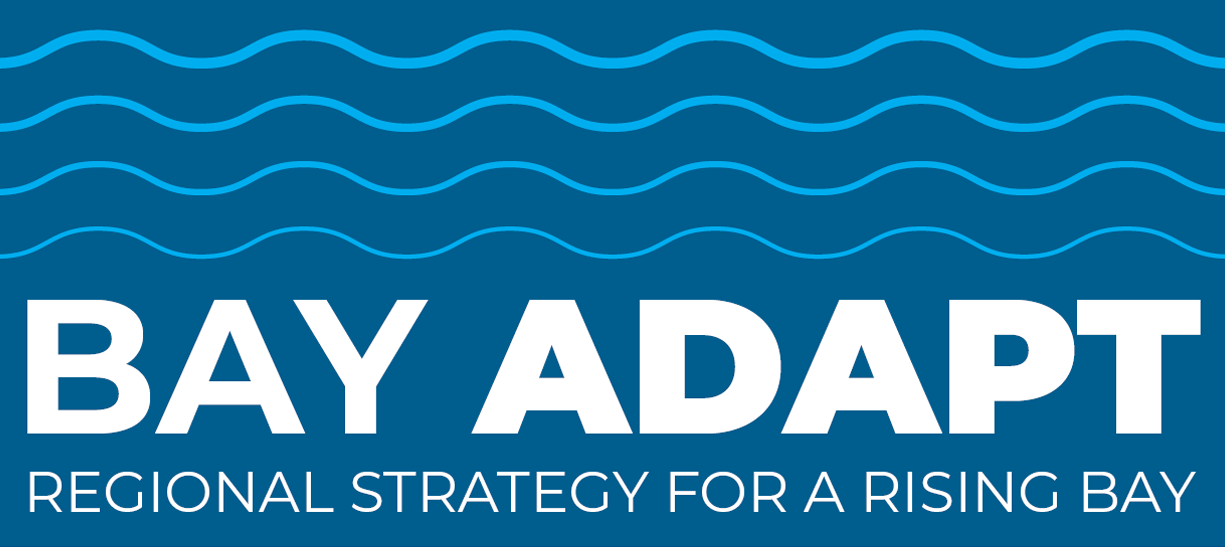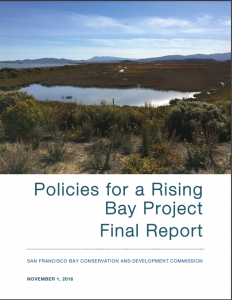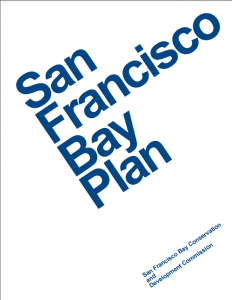
PROJECTS
Getting adaptation projects approved and built can be challenging.
Permitting and construction should accelerate, not hold back, resilient shoreline adaptation projects that value ecosystems and people, align with the region’s vision and funding priorities, and apply innovative approaches. Measures to smooth and speed regulatory approvals for multi-benefit projects are important. Other measures can help facilitate place-based collaboration around project development and remove logistical challenges to construction.
Explore Actions and Tasks
- ACTION 7. Refine and improve regulatory processes.
- Task 7.1: Accelerate permitting for equitable, multi-benefit projects.
- Task 7.2: Assess environmental regulations and policies that slow down progress on projects.
- ACTION 8. Fund and facilitate faster adaptation projects.
- Task 8.1: Incentivize projects that meet regional guidelines.
- Task 8.2: Encourage collaboration among people doing projects in the same places.
- Task 8.3: Facilitate faster construction of nature-based projects.

ACTION 7: Refine and accelerate regulatory approvals processes.
Goals:
- Less time and fewer resources spent on permitting adaptation projects so they can be constructed ahead of sea level rise.
- Updated laws, regulations, and policies that reflect the changing shoreline.
TASK 7.1: Accelerate permitting for equitable, multi-benefit projects.
Dedicate a multi-agency group to work collaboratively on permits for adaptation projects that reflect regional guidelines and have been identified as regional priorities (see Ideas for the Bay Area at right for a possible model or forum). Achieve smoother, speedier regulatory approvals that don’t compromise environmental protections, transparency, or community engagement by:
- Using standard, transparent criteria and checklists (linked to Task 1.1. guidelines) to evaluate candidate projects for eligibility for accelerated permitting.
- Providing opportunities for proactive coordination and collaboration between agencies and project proponents and sharing criteria and checklists with project proponents early in their design process.
- Improving coordination across agencies and between potential project proponents and regulators before projects are even designed (such as regular engagement with the groups outlined in Task 8.2).
- Establishing a dispute resolution process among permitting agencies.
- Conducting CEQA and permitting concurrently.
- Enhancing the technical knowledge of permitting staff (via working groups and by tapping outside expertise).
- Increasing regulatory capacity for permit review.
See Task 7.1 in the Draft Implementation Brief for details and ideas for advancing the Joint Platform actions.
The San Francisco Bay Restoration Regulatory Integration Team (BRRIT) is a multi-agency team dedicated to improving the permitting of multi-benefit habitat restoration projects and associated flood management and public access in and along San Francisco Bay. The BRRIT consists of staff from state and federal regulatory agencies who work closely with project proponents from the pre-permit application stage through permit completion. However, the BRRIT is a small team that reviews only a limited number of habitat projects and has a limited scope. The BRRIT could be expanded to cover additional green or hybrid shoreline protection projects, or a similar team could be created to handle projects that provide regional adaptation benefit but do not meet current BRRIT criteria.

TASK 7.2: Assess environmental regulations and policies that slow down progress on projects.
Review plans and laws, including BCDC’s Bay Plan, RWQCB’s Basin Plan, the California Endangered Species Act, California Environmental Quality Act, National Environmental Policy Act, Federal Clean Water Act, and Federal Endangered Species Act, to pinpoint policies that may unintentionally impede permitting or construction of adaptation projects. Starting with local and regional plans and policies, develop consensus on recommended policy changes that balance original intent with changing conditions due to sea level rise, and help facilitate multi-benefit projects. The scope of the review could include:
- Clarifying or creating new policies on climate change.
- Identifying conflicting regulatory mandates.
- Identification of “regulatory gaps,” such as wetland migration space that is not currently protected.
- Clarifying design standards for nature-based projects.
- Integrating data from pilot projects into planning for new projects.
- Reevaluating restrictions on Bay fill for shoreline protection.
- Reevaluating criteria for dredged material disposal to incentivize beneficial reuse over in-Bay or ocean disposal.
- Reevaluating contaminant criteria for beneficial reuse.
- Identifying more funding sources for sediment delivery to beneficial reuse sites and other adaptation projects.
- Updating land use policies to allow for habitats to migrate upland.
- Permitting that allows for temporary impacts to achieve long-term adaptation goals.
- Ensuring that construction work windows provide the expected benefit to special status species.
- Addressing the short and long-term impacts of turbidity plumes in water.
- Strengthening requirements around long-term monitoring of adaptation outcomes to inform regulatory and policy updates.
See Task 7.2 in the Draft Implementation Brief for details and ideas for advancing the Joint Platform actions.
In 2016, BCDC completed Policies for a Rising Bay, which outlines the policy issues identified in the Commission’s laws and policies in light of new challenges, including sea level rise. The report identifies four policy issues where BCDC’s policies were found to be inadequate regarding risks associated with rising sea levels, including:
- Fill for Resilience and Adaptation – Habitat Restoration and Protection
- Fill for Resilience and Adaptation – Innovative Shoreline Solutions
- Environmental Justice and Social Equity
- Adaptive Management
In 2019, BCDC adopted its Fill for Habitat and Environmental Justice Bay Plan Amendments that formally amended its regulatory program to address these policy gaps.
Action 7 Benefits

EQUITY
Rewards projects that value inclusive engagement and equitable outcomes.

ENVIRONMENT
Rewards projects that value long-term protection of Bay habitats and natural and nature-based adaptation outcomes.

ECONOMY
Rewards projects that protect jobs, businesses, and infrastructure.

ACTION 8: Fund and facilitate faster adaptation projects.
Goals:
- Accelerated and funded projects that advance the regional adaptation vision.
- More efficient construction processes for multi-benefit, equitable shoreline adaptation projects.
TASK 8.1: Incentivize projects that meet regional guidelines.
Jump start critical local projects that also contribute to regional goals using collectively developed plan guidelines and minimum requirements (Task 1.1), tied to financial incentives (Task 6.2) and permitting incentives (Task 7.1). Projects eligible for financial incentives should be included in successful local plans that follow compatible guidelines (Task 5.1).
Guidelines should be developed with the input of many stakeholders but may provide:
- Guidance on how to prioritize and include vulnerable communities in sea level rise projects, such as through robust and meaningful community engagement in the project planning process.
- Evaluation of the degree to which a project protects the health of the bay and local ecosystems, and considers space for habitat migration.
- Evaluation of project impacts on flooding or wave erosion in other areas of the Bay, and guidance for best practices to avoid unintended consequences in an interconnected Bay system.
- Evaluation of project impacts on natural areas, frontline communities, public access, and other consequences to neighbors or the region, such as displacement.
- Use of an equitable cost-benefit analysis that values frontline communities and other non-monetary benefits.
- Adaptive project plans that consider flooding above and beyond the design level or flooding that occurs more rapidly than planned.
Guidelines should be made easily accessible via regional technical assistance programs (Task 4.2).
See Task 8.1 in the Draft Implementation Brief for details and ideas for advancing the Joint Platform actions.
TASK 8.2: Encourage collaboration among people doing projects in the same places
Establish place-based, ongoing work groups to coordinate large-scale, multi-jurisdictional plans and projects. Provide a forum for building relationships among agencies, project proponents, and communities, enhancing communication, transparency, and synergies among diverse players, and connecting communities to projects they care about.
Create local visions tied to the regional vision (Task 1.1) and share best practices for project design, governance, and delivery. Use a neutral, third-party facilitator to facilitate these groups and help ensure a balance of voices, achieve consensus on common project goals, resolve challenges and conflicts, identify and nurture of project champions, and broker community benefits agreements. Consider formalizing these structures such as in the Hayward example (above) to accelerate project funding, development and construction across jurisdictional boundaries.
See Task 8.2 in the Draft Implementation Brief for details and ideas for advancing the Joint Platform actions.
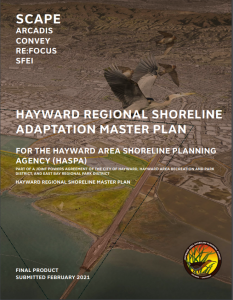
The Hayward Area Shoreline Planning Agency Joint Powers Authority brings together the City of Hayward, East Bay Regional Parks District, and Hayward Area Recreation and Parks District and works with the Hayward Area Shoreline Citizens Advisory Committee to coordinate agency planning activities and adopt and carry out policies for the improvement of the Hayward Shoreline. It has recently completed and adopted a Shoreline Master Plan that outlines adaptation measures to prepare for sea level rise. Read it Here.
TASK 8.3: Facilitate faster construction of nature-based projects.
Increase the capacity of contractors to build multi-benefit or nature-based projects. Establish training programs on techniques and approaches to construct natural and nature-based shoreline projects for contractors, aligned with regional project guidelines (Task 1.1) and informed by monitoring data (Task 9.2). Coordinate the use of the limited regional supply of fill across the region and improve fill logistics (e.g. stockpiling, contaminant testing, delivery, etc). Strengthen partnerships with regulated communities. Expand RFP and State bond proposition language to make funding such complex projects more flexible.
Improve construction bidding and contracting processes by:
- Demystifying project costs.
- Contracting earlier in the design process (via construction management general contracts).
- Incentivizing contracts with local or equity-focused businesses.
- Incentivizing the reduction of construction impacts on communities.
See Task 8.3 in the Draft Implementation Brief for details and ideas for advancing the Joint Platform actions.
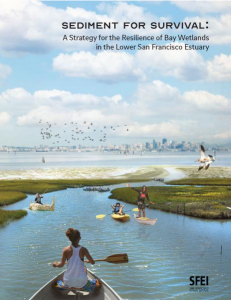 Sediment for Survival, published by the San Francisco Estuary Institute in 2021, analyzes current data and climate projections to determine how much natural sediment may be available for tidal marshes and mudflats and how much supplemental sediment may be needed under different future scenarios, and offers a strategy for sediment delivery that will enable wetlands to survive a changing climate and provide benefits to people and nature for many decades to come. This report can form the foundation for a region-wide conversation about how to meet the region’s future sediment needs for nature-based shoreline adaptation projects. Read it Here.
Sediment for Survival, published by the San Francisco Estuary Institute in 2021, analyzes current data and climate projections to determine how much natural sediment may be available for tidal marshes and mudflats and how much supplemental sediment may be needed under different future scenarios, and offers a strategy for sediment delivery that will enable wetlands to survive a changing climate and provide benefits to people and nature for many decades to come. This report can form the foundation for a region-wide conversation about how to meet the region’s future sediment needs for nature-based shoreline adaptation projects. Read it Here.
Action 8 Benefits

EQUITY
Advocates for community voices in projects; supports construction practices that minimize impacts to communities and support local businesses.

ENVIRONMENT
Expands the ability of contractors to build natural and nature-based solutions.

ECONOMY
Facilitates cross-pollination early on, resulting in multi-benefit projects with shared costs; supports construction practices that support local businesses.
